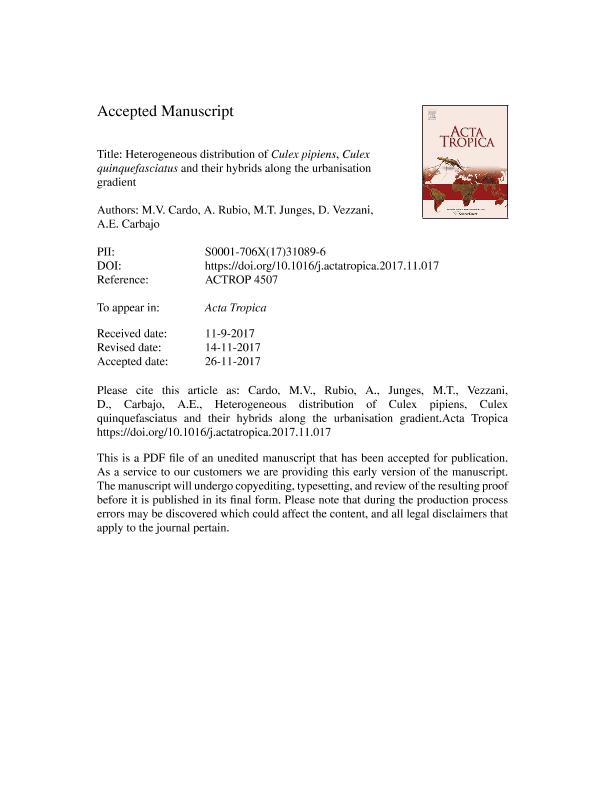Mostrar el registro sencillo del ítem
dc.contributor.author
Cardo, María Victoria

dc.contributor.author
Rubio, Alejandra

dc.contributor.author
Junges, Melania Teresita

dc.contributor.author
Vezzani, Dario

dc.contributor.author
Carbajo, Anibal Eduardo

dc.date.available
2018-09-12T17:02:15Z
dc.date.issued
2018-02
dc.identifier.citation
Cardo, María Victoria; Rubio, Alejandra; Junges, Melania Teresita; Vezzani, Dario; Carbajo, Anibal Eduardo; Heterogeneous distribution of Culex pipiens, Culex quinquefasciatus and their hybrids along the urbanisation gradient; Elsevier Science; Acta Tropica; 178; 2-2018; 229-235
dc.identifier.issn
0001-706X
dc.identifier.uri
http://hdl.handle.net/11336/59314
dc.description.abstract
The mosquitoes of the Culex pipiens complex, hereafter referred to as the Pipiens Assemblage, are vectors of arbovirus of worldwide concern including West Nile and St. Louis encephalitis. Given their distinct eco-physiology and vectorial capacity, accurate specimen identification and insight in the environmental drivers of their distribution are essential for the understanding of disease transmission patterns. Using a PCR-based identification protocol, we characterized the spatial distribution of Cx. pipiens, Cx. quinquefasciatus and their hybrids developing in used tyres located within the overlapping region in South America as a function of different estimators of the urbanisation gradient. Out of 84 samples collected from tyre piles of 20 sites, we identified 369 larvae which corresponded predominantly to Cx. quinquefasciatus (76.4% of immatures) all along the gradient but more frequent at the urban end. Cx. pipiens (21.4%) was more conspicuous at the low urbanised end but was also present in highly urbanised sites, whereas hybrids were collected in very low numbers (2.2%). The urbanisation estimator best associated with the heterogeneous occurrence of the Pipiens Assemblage members was the proportion of impervious surface 1 km around each tyre pile, which explained 41.7% of the variability in the data, followed closely by the distance to the Capital City (38.3%). Cumulative annual precipitation, population number in a 1 km radius around each pile and distance to the de la Plata River were significantly associated with the distribution of the Pipiens Assemblage at lower explanation percentages (20–23%). A thorough understanding of the ecological basis and environmental associations of the distribution of Pipiens Assemblage members will enable forecasting population trends in changing environments to develop effective control measures for mosquitoes and the diseases they transmit.
dc.format
application/pdf
dc.language.iso
eng
dc.publisher
Elsevier Science

dc.rights
info:eu-repo/semantics/openAccess
dc.rights.uri
https://creativecommons.org/licenses/by-nc-nd/2.5/ar/
dc.subject
Arbovirus
dc.subject
Demography
dc.subject
Discarded Tyres
dc.subject
Impervious Area
dc.subject
Pipiens Assemblage
dc.subject
Polymerase Chain Reaction
dc.subject.classification
Otras Ciencias Biológicas

dc.subject.classification
Ciencias Biológicas

dc.subject.classification
CIENCIAS NATURALES Y EXACTAS

dc.title
Heterogeneous distribution of Culex pipiens, Culex quinquefasciatus and their hybrids along the urbanisation gradient
dc.type
info:eu-repo/semantics/article
dc.type
info:ar-repo/semantics/artículo
dc.type
info:eu-repo/semantics/publishedVersion
dc.date.updated
2018-09-10T13:22:13Z
dc.journal.volume
178
dc.journal.pagination
229-235
dc.journal.pais
Países Bajos

dc.journal.ciudad
Amsterdam
dc.description.fil
Fil: Cardo, María Victoria. Universidad Nacional de San Martín. Instituto de Investigaciones e Ingeniería Ambiental. Laboratorio de Ecología de Enfermedades Transmitidas por Vectores; Argentina. Consejo Nacional de Investigaciones Científicas y Técnicas; Argentina
dc.description.fil
Fil: Rubio, Alejandra. Universidad Nacional de San Martín. Instituto de Investigaciones e Ingeniería Ambiental. Laboratorio de Ecología de Enfermedades Transmitidas por Vectores; Argentina. Consejo Nacional de Investigaciones Científicas y Técnicas; Argentina
dc.description.fil
Fil: Junges, Melania Teresita. Universidad Nacional de San Martín. Instituto de Investigaciones e Ingeniería Ambiental. Laboratorio de Ecología de Enfermedades Transmitidas por Vectores; Argentina. Consejo Nacional de Investigaciones Científicas y Técnicas; Argentina
dc.description.fil
Fil: Vezzani, Dario. Universidad Nacional del Centro de la Provincia de Buenos Aires. Facultad de Ciencias Exactas. Instituto Multidisciplinario de Ecosistemas y Desarrollo Sustentable; Argentina. Consejo Nacional de Investigaciones Científicas y Técnicas; Argentina
dc.description.fil
Fil: Carbajo, Anibal Eduardo. Universidad Nacional de San Martín. Instituto de Investigaciones e Ingeniería Ambiental. Laboratorio de Ecología de Enfermedades Transmitidas por Vectores; Argentina. Consejo Nacional de Investigaciones Científicas y Técnicas; Argentina
dc.journal.title
Acta Tropica

dc.relation.alternativeid
info:eu-repo/semantics/altIdentifier/doi/http://dx.doi.org/10.1016/j.actatropica.2017.11.017
dc.relation.alternativeid
info:eu-repo/semantics/altIdentifier/url/https://www.sciencedirect.com/science/article/pii/S0001706X17310896
Archivos asociados
